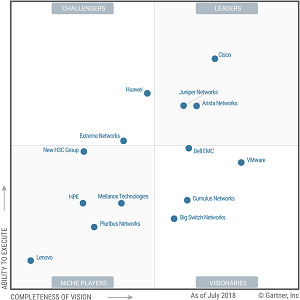News
SDN Firms Lead Datacenter Networking Research Report
One thing common to all three "leaders" named in Gartner's July datacenter networking research report is that they all offer software-defined networking (SDN).
The software-centric approach has disrupted the traditional hardware-based industry over the past several years, providing programmability, agility, interoperability and many other benefits over legacy, closed and proprietary systems.
In fact, the outright "leader" in Gartner's Magic Quadrant report, Cisco Systems, recently declared the software-centric intent-based networking (IBN) approach would guide its future direction, calling it the company's "biggest innovation in the past decade."
The software-driven IBN is related to SDN, as IDC analyst Rohit Mehra was quoted as saying IBN brings SDN to the enterprise level.
As Cisco moves to IBN, its current offerings include its own flavor of SDN, which it calls Application Centric Infrastructure (ACI). Cisco calls ACI "the industry leading software defined networking (SDN) solution" that "enables application agility and datacenter automation."
 [Click on image for larger view.] Gartner July Magic Quadrant Report on Datacenter Networking (source: Gartner, via Cisco).
[Click on image for larger view.] Gartner July Magic Quadrant Report on Datacenter Networking (source: Gartner, via Cisco).
In its July Magic Quadrant report for datacenter networking, Gartner focused on ACI in its coverage of the company. "Cisco offers a broad array of infrastructure hardware and software, and its flagship datacenter networking offering is Cisco ACI, which includes Nexus 9000 hardware switches and the APIC controller," the report said.
However, Gartner also offered some "cautions" on the product, with one stating: "Based on client feedback and Gartner's analysis, migrating from legacy infrastructure to Cisco ACI infrastructure is complex for a combination of financial, technical and cultural reasons. This has led to limited ACI adoption in the market, and also limited usage of the full ACI feature for customers that have adopted it."
The other two companies joining Cisco in the "leaders" quadrant were Juniper Networks and Arista Networks.
Juniper says its SDN products help organizations "future-proof for the cloud era with an open SDN solution that provides high performance, elasticity, and security."
Juniper also has joined the IBN party, and Gartner took note of that, saying, "Juniper's vision and product roadmap to deliver an intent-based datacenter network with self-healing capabilities, based on open standards, align with emerging customer requirements."
One of the report's "cautions" about the company says, "Juniper provides certified product integration with VMware NSX, but also competes with NSX via the Contrail orchestration product. The two companies pursue their sales strategies (partnering versus competing) on an account-by-account basis, which can confuse clients."
Arista, meanwhile, touts its software-driven cloud networking portfolio. It says: "Arista Software Driven Cloud Networking (SDCN), combines the principles that have made cloud computing the unstoppable force that it is: automation, self service provisioning, and linear scaling of both performance and economics coupled with the recent trend in Software Driven Cloud Networking that delivers: network virtualization, custom programmability, simplified architectures, and more realistic price points to the table."
The Magic Quadrant report also notes Arista's cloud focus, focusing on the company's Universal Cloud Network (UCN) offering. One of the "strengths" of Arista is that it's "experienced and well-regarded by customers in large-scale environments that require programmable infrastructure that are integrated with a wide range of third-party software orchestration, including VMware, Puppet and Ansible."
A contrasting "caution" indicates it might not be fully onboard with SDN's disruptive tenets, saying "Arista focuses on incremental, nondisruptive innovation, which does not always address the needs of organizations that want to fundamentally transform the way they operate their datacenter networks."
Gartner generally noted the influence of SDN, especially concerning SDN overlays, saying "with the emergence of network virtualization and new architectural models like software-defined networking, software overlays became an additional option in the market and are considered in this Magic Quadrant."
Cisco offered up a reprint of the Gartner report, which can be accessed here.
About the Author
David Ramel is an editor and writer for Converge360.